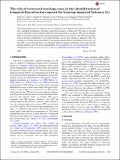| dc.contributor.author | Leger, Agnes C. | |
| dc.contributor.author | Desloge, Joseph G. | |
| dc.contributor.author | Braida, Louis D. | |
| dc.contributor.author | Swaminathan, Jayaganesh | |
| dc.date.accessioned | 2015-11-10T19:15:53Z | |
| dc.date.available | 2015-11-10T19:15:53Z | |
| dc.date.issued | 2015-01 | |
| dc.date.submitted | 2014-11 | |
| dc.identifier.issn | 0001-4966 | |
| dc.identifier.uri | http://hdl.handle.net/1721.1/99895 | |
| dc.description.abstract | Narrowband speech can be separated into fast temporal cues [temporal fine structure (TFS)], and slow amplitude modulations (envelope). Speech processed to contain only TFS leads to envelope recovery through cochlear filtering, which has been suggested to account for TFS-speech intelligibility for normal-hearing listeners. Hearing-impaired listeners have deficits with TFS-speech identification, but the contribution of recovered-envelope cues to these deficits is unknown. This was assessed for hearing-impaired listeners by measuring identification of disyllables processed to contain TFS or recovered-envelope cues. Hearing-impaired listeners performed worse than normal-hearing listeners, but TFS-speech intelligibility was accounted for by recovered-envelope cues for both groups. | en_US |
| dc.description.sponsorship | National Institutes of Health (U.S.) (Grant R43 DC013006) | en_US |
| dc.description.sponsorship | National Institutes of Health (U.S.) (Grant R01 DC00117) | en_US |
| dc.language.iso | en_US | |
| dc.publisher | Acoustical Society of America (ASA) | en_US |
| dc.relation.isversionof | http://dx.doi.org/10.1121/1.4904540 | en_US |
| dc.rights | Article is made available in accordance with the publisher's policy and may be subject to US copyright law. Please refer to the publisher's site for terms of use. | en_US |
| dc.source | Acoustical Society of America | en_US |
| dc.title | The role of recovered envelope cues in the identification of temporal-fine-structure speech for hearing-impaired listeners | en_US |
| dc.type | Article | en_US |
| dc.identifier.citation | Leger, Agnes C., Joseph G. Desloge, Louis D. Braida, and Jayaganesh Swaminathan. “The Role of Recovered Envelope Cues in the Identification of Temporal-Fine-Structure Speech for Hearing-Impaired Listeners.” J. Acoust. Soc. Am. 137, no. 1 (January 2015): 505–508. © 2015 Acoustical Society of America | en_US |
| dc.contributor.department | Massachusetts Institute of Technology. Department of Electrical Engineering and Computer Science | en_US |
| dc.contributor.department | Massachusetts Institute of Technology. Research Laboratory of Electronics | en_US |
| dc.contributor.mitauthor | Leger, Agnes C. | en_US |
| dc.contributor.mitauthor | Desloge, Joseph G. | en_US |
| dc.contributor.mitauthor | Braida, Louis D. | en_US |
| dc.contributor.mitauthor | Swaminathan, Jayaganesh | en_US |
| dc.relation.journal | The Journal of the Acoustical Society of America | en_US |
| dc.eprint.version | Final published version | en_US |
| dc.type.uri | http://purl.org/eprint/type/JournalArticle | en_US |
| eprint.status | http://purl.org/eprint/status/PeerReviewed | en_US |
| dspace.orderedauthors | Leger, Agnes C.; Desloge, Joseph G.; Braida, Louis D.; Swaminathan, Jayaganesh | en_US |
| dc.identifier.orcid | https://orcid.org/0000-0002-8431-4730 | |
| dc.identifier.orcid | https://orcid.org/0000-0003-2538-9991 | |
| mit.license | PUBLISHER_POLICY | en_US |
| mit.metadata.status | Complete | |
